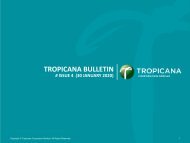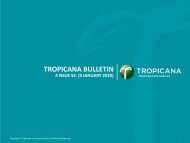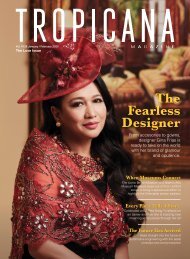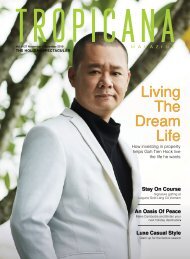Tropicana Magazine Jan-Feb 2018 #116: A Start From The Heart
Start fresh in the year of 2018. Expat Educator Ian Temple shares his own unexpected journey in shaping young minds at Tenby Schools; Check out your Chinese Zodiac for some predictions on fortune; Melbourne's Coolest Bars will blow you mind; all that and more this issue.
Start fresh in the year of 2018. Expat Educator Ian Temple shares his own unexpected journey in shaping young minds at Tenby Schools; Check out your Chinese Zodiac for some predictions on fortune; Melbourne's Coolest Bars will blow you mind; all that and more this issue.
You also want an ePaper? Increase the reach of your titles
YUMPU automatically turns print PDFs into web optimized ePapers that Google loves.
FASHION FEATURE<br />
THE ALLURE<br />
OF THE<br />
CHEONGSAM<br />
<strong>From</strong> swinging Shanghai to Suzie Wong, the slit skirt cheongsam<br />
has been thrust into modern, popular fashion consciousness.<br />
WORDS BY JEAN KNILL<br />
WARDROBE BY KHOON HOOI<br />
<strong>The</strong> current incarnation of the Chinese Cheongsam adorns lovely<br />
women the world over. <strong>The</strong> name evokes a vision of willowy, modellike<br />
beauties clad in figure-hugging, shiny fabric, buttoned up on the<br />
right, with high mandarin collars and sexy slit skirts.<br />
It hasn’t always been like that. <strong>The</strong> garment originated in northern<br />
China in the 17th century, the time of the Manchu rulers. <strong>The</strong> straight up<br />
and down, long dress with sleeves was first worn by women and later also by<br />
men. By the middle of the century, wearing it was the law, with execution<br />
the penalty for not conforming. Its name was different too. <strong>The</strong>y called it a<br />
qipao, a word still used in the north of China, while people in the south call<br />
it by the name recognised in the western world – the cheongsam.<br />
Qipao means banner dress, and the origin of this name is political.<br />
<strong>The</strong> Manchu were all Banner People who were placed in an administrative<br />
system based on Eight Banners. <strong>The</strong> banners depict Chinese dragons on<br />
four different coloured backgrounds, with or without borders. <strong>The</strong>ir nature<br />
was hierarchical, with the plain yellow, the bordered yellow and the plain<br />
white banners at the top of the tree, and initially under the direction of the<br />
Emperor. Originally set up to form armies, they later took on administrative<br />
duties and became the basis of a society made up of Manchus, Han Chinese<br />
and Mongols. Hence, their national costume was called a banner dress.<br />
TM | JANUARY/FEBRUARY <strong>2018</strong><br />
70


















